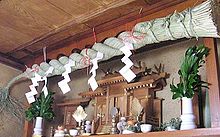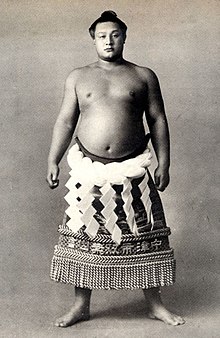Shimenawa

Shimenawa ( Japanese 注 連 縄 , more rarely 標 縄 and 七五 三 縄 ) are whipped ropes made of rice straw, which in Shintō separate the world of the gods ( kami ) from the world of this world.
Shimenawa also mark demarcated places of residence of the Kami and are intended to symbolize the presence of a god or a divine force.
etymology
The exact meaning and etymology of Shimenawa is controversial despite this widespread use and is not canonically determined. According to Basil Hall Chamberlain and Motoori Norinaga , who refer to the Kogoshūi , the archaic version of the word shiri-kume-nawa ( 斯利 久 迷 繩 ) means "straw rope braided backwards," which means that the straw rope is made in this way is that the roots stick out and so are visible at the ends.
This name goes back to an event of the mythological age handed down through the Kojiki and Nihonshoki . According to legend, Amaterasu , the sun goddess, was offended by the behavior of Susa-no-O-no-Mikoto , her brother, in a rock cave. Since the light emanating from Amaterasu could no longer reach the world and the world was thus shrouded in darkness, the other gods try to lure her out of her hiding place again. When Amaterasu opened the gate to her cave and stepped out a little, Futo-Tama no Mikoto stretched a shiri-kume-nawa behind her back so that she could not step back into the rock cave.
In Kojiki the word shiri-kume-nawa ( 尻 久 米 縄 ) means something like "straw rope braided backwards". The Nihonshoki, which tells the same story and also calls the rope shiri-kume-nawa ( 端出 之 縄 or 左 縄 端出 ), spells the word differently, so that it means "straw rope with hanging ends" or " left straw rope ”results.
With the "hanging out ends" are probably meant the hanging roots that resulted from the interweaving with the stalks and then protruded. Today these root ends are indicated by special straws that are attached to the rope and hang from it.
In contrast to Basil Hall Chamberlain and Motoori Norinaga, the Shinto expert Katō Genchi explained that shime based on the term shimeno ( 標 野 , “forbidden place”) means “forbidden; Taboo ”means that shimenawa are“ taboo ropes ”. According to this, Shimenawa should serve as taboo signs that mark the place where they are attached as a place dedicated to the kami, deprived of profane uses, sanctified and protected from contamination ( kegare ) of any kind. Even more prosaic etymologies lead the term back to the verbs shimesu ( 示 , or 標 “to indicate [a particular area]”) or shimeru ( 締 , “to tie together”).
Occasionally one finds the modern translation “god rope” for Shimenawa.
use



As symbols of the presence of divine presence, such ropes are mostly found in Shinto religious sites such as shrines , torii and other holy places such as impressive trees or rocks. The largest Shimenawa is located on the Kaguraden of the Izumo Taisha and has a length of 13 m, a circumference of 9 m and weighs 5 tons.
Shimenawa seldom connect two or more objects with each other, like the two stones of the Meoto-Iwa , or at the Yoshida shrine , where eight Shimenawa tie the hill of misery ( yaku-zuka ) in front of the door of the holy of holies ( honden ).
House shrines ( Kamidana ) are also decorated with Shimenawa. Some are no thicker than an ordinary thread, others can reach a diameter of more than two meters.
At the New Year , it is also a widespread custom in Japan to hang little Shimenawa over house entrances and gates as protection against disease and evil.
Shimenawa are usually hung with zigzag cut and specially folded strips of paper ( shide ), which in turn are attached to wooden sticks (together gohei ), and pendants made of flax ( yū ), which have a purifying, but also decorative and indicative meaning for holy places to have. They come from older types of heihaku , offerings to the gods.
Shimenawa are sometimes also used to mark numinous places in the wild, e.g. B. on strikingly shaped rocks in the sea. The application of the artfully braided Shimenawa is accompanied by elaborate ceremonies ( shimenawa-taki ). Such a ceremony, which is said to go back to Kono Michinobu, a commander of the Gempei War , originally served to ask a dragon god for calm seas. To commemorate this event, a ceremonial production of a Shimenawa takes place in the city of Hōjō on the Japanese Seto Inland Sea .
Manufacturing
This section describes how Shimenawa is made using an example from Ibaraki , Osaka Prefecture .
In a medium-sized shrine in the Japanese city of Ibaraki, an approximately 35 cm thick Shimenawa is attached above the entrance of the main building and another approximately 25 cm thick rope under the crossbar of the local torii. Since the rope is above the main portal under a canopy, this has a shelf life of one year. The Shimenawa under the torii, which is often exposed to rain, has to be replaced after half a year.
Consequently, three large Shimenawa are required annually for this shrine. These are made on a December weekend during a joint work assignment of the male community members. The decision was made to manufacture them in-house, as manufacturing them by a company would have cost around 70,000 yen (around 500 euros) for each of the three 4 to 5 meter long ropes. (As of 2009)
It takes two days and around 10 men to make it. The rice straw from the harvest of the same year is used as the raw material. The first day is mainly used to free the straw from the ears and to start making the 10 to 15 cm thick cardeles . For this purpose, a correspondingly thick bale of straw made of about 80 cm long straws is wrapped with a rope. In order to gain length, the bale is widened a little at one end and another bale of straw is inserted into the opening that has been created, but only up to a part. The rest sticks out, is now also tied around with the rope and then widened a little to put in another bale of straw. This procedure is continued until the desired length is reached.
In this case, three cardels and a bamboo stick are required to finish a Shimenawa. Due to its torsional stiffness, this prevents the later Shimenawa from turning open. This may also prevent the Shimenawa from tearing due to its own weight. The three cardeles and the bamboo stick are firmly connected to each other at one end with wire. For the last step, this end is attached to a rotatable axle. Then each of the cardeles is twisted by two to three men. This is traditionally done to the right. Meanwhile, the axis with the bamboo stick is rotated piece by piece so that the cardeles wrap around the stick to the left. The different directions of rotation of the cardeles and the entire rope mean that despite the double helix of the individual straws, they run parallel to the direction of the rope on the outside of the Shimenawa.
The Shimenawa is attached in a ceremonial setting at the turn of the year. The actual production of the ropes, on the other hand, has more of the character of a community-building work effort.
Sumo

The rope with Gohei that the yokozuna wear in sumo resembles a Shimenawa.
Since sumo wrestling has always had strong ties to Shinto, there are speculations that it is derived from the Shimenawa.
Especially at the beginning and end of a competition, sumo wrestlers wear splendid aprons made of the aforementioned ropes, on which zigzag-shaped shides made of white paper are often attached, which are also found on many Shimenawa.
Furthermore, the sumo ring is usually enclosed by a kind of Shimenawa.
Individual evidence
- ↑ a b Kogoshūi. Gleanings from Ancient Stories . Tokyo 1926, p. 22 ( digitized version ).
- ↑ Karl Reitz: The rite of the Shinto worship service ( page no longer available , search in web archives ) Info: The link was automatically marked as defective. Please check the link according to the instructions and then remove this notice. - Retrieved May 12, 2008
- ↑ Shimenawa (Motosawa Masashi, Encyclopedia of Shinto ) - accessed September 20, 2010
- ↑ What is a shrine? (Bernhard Scheid, Religion-in-Japan ) - Retrieved September 20, 2010
- ↑ Keiko Onozuka and Thomas Wilhelm: Shintoism - accessed on May 12, 2008
- ↑ Shimenawa (Bernhard Scheid, Religion-in-Japan ) - accessed on September 20, 2010
Web links
- Motosawa Masashi: "Shimenawa" . In: Encyclopedia of Shinto. Kokugaku-in , September 1, 2005 (English)
- Information on Very Large Array by Peter Schmidt - English